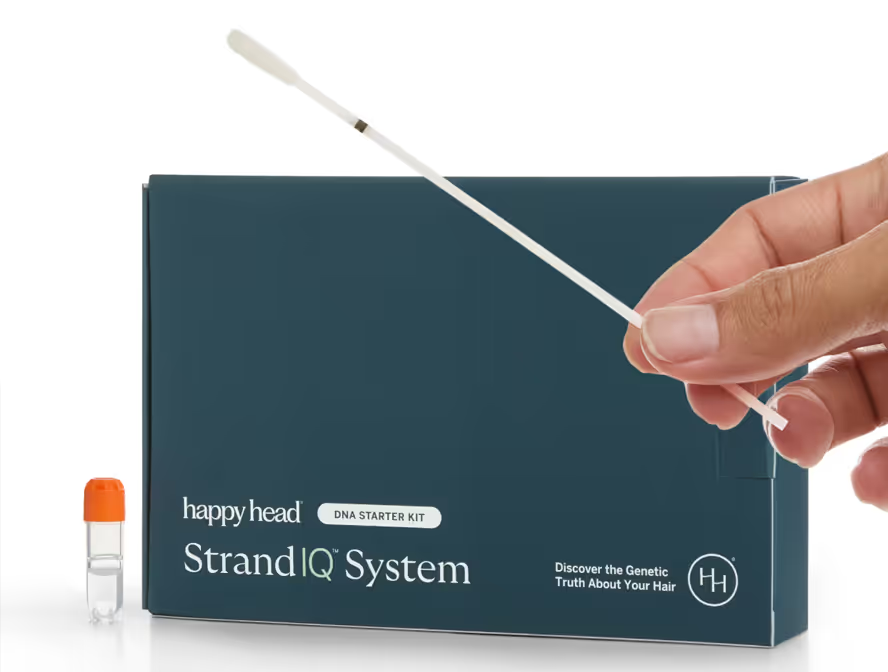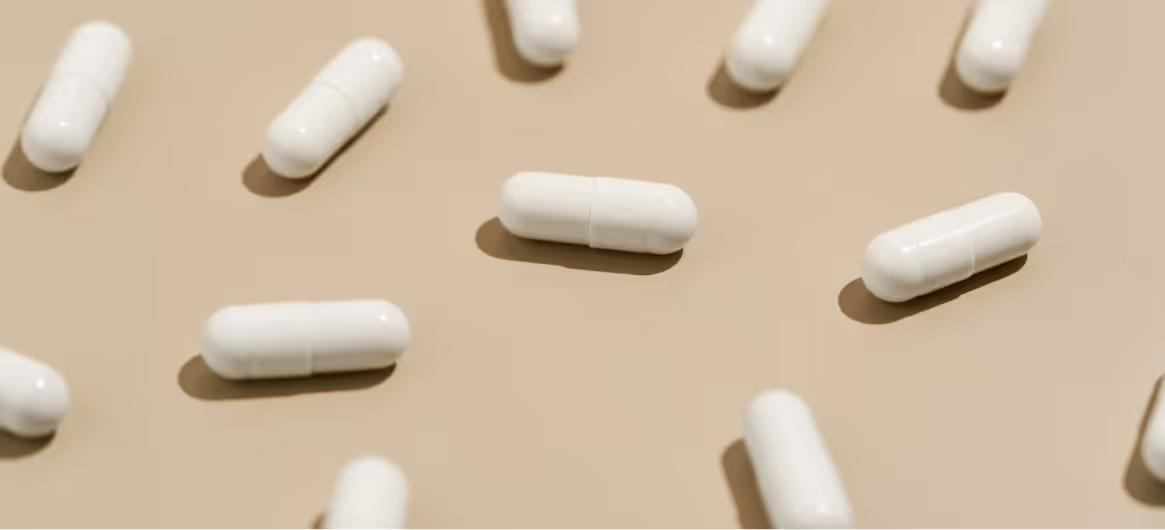Selenium is a trace mineral with an outsized impact on hair growth and scalp health. It plays a dual role in both antioxidant defense and thyroid hormone function—two systems that directly influence the hair growth cycle.
In the hair follicle, selenium:
- Boosts the activity of glutathione peroxidase, a powerful antioxidant that protects follicle cells from oxidative stress.
- Supports the conversion of thyroid hormones, which regulate the hair growth cycle.
- Helps reduce inflammation around the follicle, protecting against autoimmune-driven shedding.
A deficiency can disrupt the delicate balance between follicle growth and rest phases, leading to slower regrowth, fragile strands, and sometimes increased shedding.
The Role Genetics Play in Selenium Processing
While diet plays a significant role in selenium levels, genetics can determine how efficiently your body absorbs, transports, and utilizes selenium.
Several key genetic factors influence selenium metabolism:
- SEPP1 gene variants – This gene encodes selenoprotein P, the primary selenium transport protein in the body. Certain variants can reduce its efficiency, lowering selenium delivery to the scalp and hair follicles.
- GPX1 and GPX4 gene variants – These genes produce glutathione peroxidase enzymes. Mutations can reduce the activity of these antioxidant enzymes, meaning selenium’s protective benefits are diminished.
- DIO1 and DIO2 variants – These genes help convert thyroid hormones from their inactive to active forms, a process that depends on selenium. Variants can amplify the effects of low selenium, impacting hair cycling.
- Nutrient interaction genes – Genetic differences in zinc and iodine metabolism can also indirectly affect selenium’s function in the body.
If you carry risk variants in these genes, you may require higher or more consistent selenium intake to maintain optimal hair and scalp health.
Recommendations Based on Genetic Risk
The right selenium strategy depends on your genetic predisposition, dietary habits, and lifestyle factors that influence selenium status.
Low Risk: Maintain Adequate Selenium Intake
If your Happy Head StrandIQ analysis has identified you as being at low genetic risk, maintaining selenium levels is generally straightforward with a varied diet.
- Include selenium-rich foods regularly
Prioritize a diet filled with selenium-rich foods such as crimini mushrooms, Brazil nuts, pork, beef, turkey, chicken, eggs, and seafood. - Freshness and locality are key
Locally grown produce and animal products tend to retain higher selenium levels, as some is lost during transport and storage of more widely distributed products. - Moderate exercise is beneficial
While physical activity supports overall health, overtraining can reduce selenium status, so balance is key.
Medium Risk: Boost Intake and Monitor Lifestyle Factors
If you have moderate genetic risk, your body may be less efficient at absorbing or using selenium, so consistent dietary inclusion becomes more important.
- Rotate multiple selenium sources
In addition to Brazil nuts and seafood, incorporate lentils, sunflower seeds, and whole grains for variety. - Be mindful of activity levels
High-intensity or endurance training may deplete selenium, so consider slightly higher intake during heavy training periods. - Limit alcohol with selenium-rich meals
Alcohol can interfere with selenium utilization, so it’s best consumed separately from your richest selenium sources. - Avoid excess
High doses can be toxic; stick to dietary sources unless a healthcare provider recommends supplementation.
High Risk: Combine Nutritional, Lifestyle, and Medical Strategies
If your StrandIQ report places you at high genetic risk, you may need a more targeted approach to prevent deficiency and its impact on hair growth.
- Daily dietary selenium is essential
Aim for a consistent intake of seafood, organ meats, eggs, and Brazil nuts—just one or two Brazil nuts per day can meet daily needs. - Dairy for selenium boost
Milk and yogurt can contribute additional selenium while supporting protein intake for hair health. - Adjust for physical stressors
Illness, chronic stress, and intense training all raise selenium demand—adjust dietary intake accordingly. - Supplement with supervision
Before starting selenium supplements, check blood levels and consult a provider. Excess selenium can cause brittle hair, nail changes, and other toxicity symptoms. - Avoid compounding risks
Limit alcohol and smoking, as both can accelerate oxidative stress and counteract selenium’s protective effects.
Selenium Deficiency and Hair Loss: The Biological Connection
The link between selenium and hair health is supported by both clinical research and case studies. Selenium deficiency can contribute to telogen effluvium, a temporary but often distressing form of hair shedding. In severe deficiency, structural changes in the hair shaft can occur, leading to brittleness and breakage.
On the other hand, excess selenium can be jus
t as harmful—a reminder that balance is crucial.
Taking a Genetic-Informed Approach
Genetics offer valuable insight into how our bodies handle selenium. If you carry variants that affect absorption, transport, or utilization, you can adjust your diet and lifestyle accordingly. This might mean more frequent inclusion of selenium-rich foods, strategic pairing with other nutrients, or closer monitoring of blood levels.
The good news is that selenium is relatively easy to source from food, and even small daily amounts can have a significant impact on scalp health and hair growth.
Resources
StrandIQ SNP Marker Count: 12
StrandIQ Genes for Trait:
ARSB, BHMT, CBS, DMGDH, FAM135B, HOMER1, KYNU, LINC01695, MTMR7, PRKG1, SDCCAG8, TCF7
References:
Batai, K., et al. (2021). Genome-wide association study of response to selenium supplementation and circulating selenium concentrations in adults of European descent. Journal of Nutrition, 151(2), 293–302. PMID: 33382417.
Cornelis, M.C., et al. (2015). Genome-wide association study of selenium concentrations. Human Molecular Genetics, 24(5), 1469–1477. PMID: 25343990.
Evans, D.M., et al. (2013). Genome-wide association study identifies loci affecting blood copper, selenium and zinc. Human Molecular Genetics, 22(19), 3998–4006. PMID: 23720494.
Gong, J., et al. (2013). Genome-wide association study of serum selenium concentrations. Nutrients, 5(5), 1706–1718. PMID: 23698163.
Huang, T., et al. (2024). Genetically predicted circulating concentrations of micronutrients and risk of hypertensive disorders of pregnancy: a Mendelian randomization study. Archives of Gynecology and Obstetrics, 310, 1019–1025.
Li, J., et al. (2023). Causal effect of selenium levels on osteoporosis: a Mendelian randomization study. Nutrients, 15(24), 5065.
Liu, K., et al. (2024). Genetically determined circulating micronutrients and the risk of nonalcoholic fatty liver disease. Scientific Reports, 14(1), 1105. PMID: 38212362.
Moksnes, M.R., et al. (2024). A genome-wide association study provides insights into the genetic etiology of 57 essential and non-essential trace elements in humans. Communications Biology, 7, 432.
Sharma, P., et al. (2024). Genetic determinants of selenium availability, selenium-response, and risk of polycystic ovary syndrome. Biological Trace Element Research, 202(11), 4843–4857. PMID: 38227265.
Yang, W., et al. (2022). Genome-wide association and Mendelian randomization study of blood copper levels and 213 deep phenotypes in humans. Communications Biology, 5(1), 405. PMID: 35501403.
This content, including StrandIQ™ DNA analysis reports and any Happy Head products and/or services referenced therein, is for informational and cosmetic purposes only. It is not intended to diagnose, treat, cure, or prevent any disease. This content does not constitute medical advice and should not be used to make healthcare decisions. References to prescription treatments are educational in nature. Always consult a licensed healthcare professional for any medical concerns or treatment decisions.








.avif)

